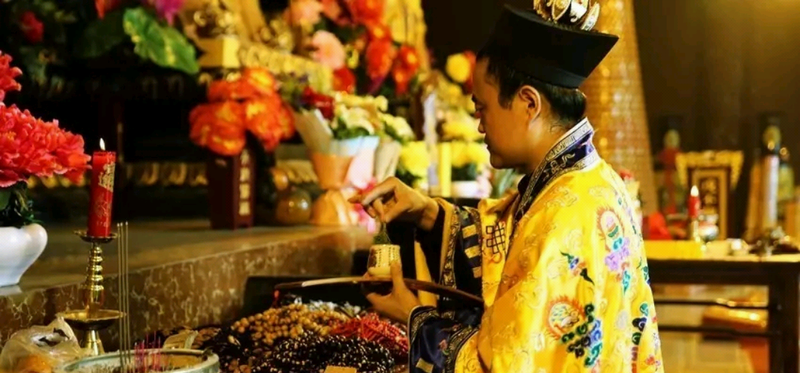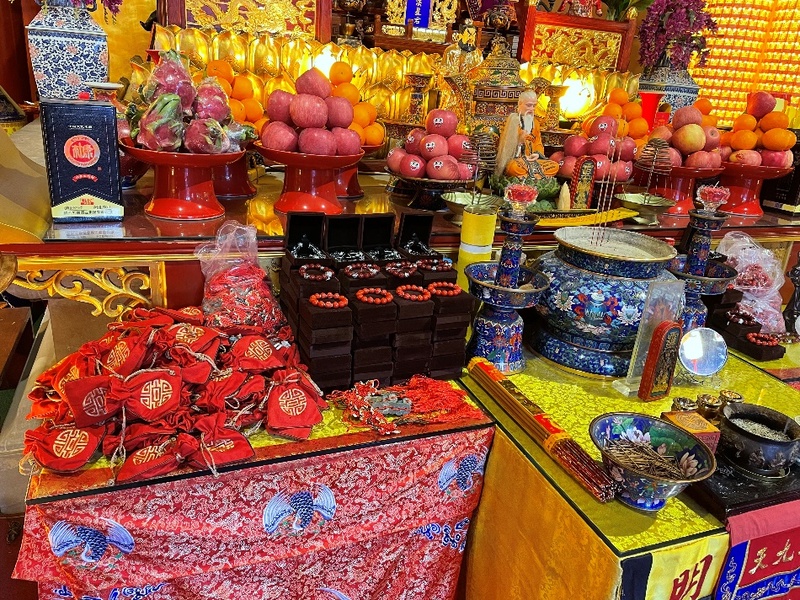What Is "Spiritual Consecration"?

In China’s spiritual and cultural traditions, "Spiritual Consecration" (kāiguāng, 开光) is a sacred ritual that transforms objects—such as jewelry, statues, or talismans—into vessels for focused energy and divine connection. Far more than a generic "blessing," it is a deliberate, ceremonial process to awaken an object’s potential to hold, amplify, and channel spiritual power, bridging the physical world with realms of higher wisdom.
Cultural & Religious Roots
The practice emerges from two foundational Chinese philosophies: Buddhism and Taoism, each shaping its meaning and rituals:
1. Buddhist Context
In Buddhism, consecration (开光) is often performed on statues of Buddha or bodhisattvas (enlightened beings) to invite their sacred presence into the physical form. Monks chant sutras (sacred texts), purify the object with holy water or incense, and perform a symbolic act called "opening the eyes" (开眼,kāi yǎn). This ritual signifies awakening the statue’s inherent wisdom and compassion, transforming it from a mere sculpture into a focal point for devotion and spiritual guidance.
2. Taoist Context
Taoism uses consecration to infuse talismans (符咒,fú zhòu) or ritual tools with the energies of nature and the cosmos. Practitioners believe this process turns objects into channels for harmonizing Qi (气,the universal life force), invoking protection, or accessing divine guidance. Unlike Buddhism, Taoism focuses on aligning the object with natural laws and celestial forces to create the balance of Yin and Yang.
Key Steps of the Ritual

While rituals vary by tradition, most consecrations share these core elements:
-
Purification
The object is cleansed using natural elements—such as incense smoke, herbal-infused water, or sunlight—to remove stagnant or negative energy. This step prepares the object to receive intentional energy, much like clearing a canvas before painting. -
Invocation of Intent
A spiritual practitioner (monk, Taoist master, or experienced adept) chants mantras, prayers, or affirmations focused on specific purposes: protection, abundance, inner peace, etc. These words are seen as "programming" the object with a clear energetic mission, much like setting a compass to a specific direction. -
Energy Transfer
Through meditation, ritual gestures, or focused concentration, the practitioner channels their own vital energy or divine forces into the object. This creates a sacred bond between the physical form and the spiritual realm, making the object a living conduit for the intended energy. -
Sealing the Energy
The ritual concludes with a symbolic act—wrapping the object in sacred cloth, placing it on an altar, or reciting a final mantra—to "seal" the activated energy within. This ensures the object’s sustained connection to its spiritual purpose over time.
What Does Spiritual Consecration Achieve?
-
Energetic Activation
The object becomes a spiritual antenna, capable of absorbing, storing, and radiating specific energies. For example:- A consecrated bracelet might be designed to absorb stress and amplify calmness, acting as a wearable anchor for peace.
- A pendant could be consecrated to attract abundance, believed to align the wearer with opportunities and prosperity.
-
Symbolic Empowerment
More than a physical accessory, the object becomes a tangible symbol of intention. For the wearer, it serves as a "materialized mantra"—a touchstone that triggers mindfulness, focus, or courage. Just as a wedding ring symbolizes commitment, a consecrated bracelet symbolizes a vow to live in alignment with one’s highest self. -
Bridge to Ancient Wisdom
Consecration links the object to millennia of spiritual practice, honoring traditions while making them relevant to modern life. It transforms ancient rituals into accessible tools for personal growth, allowing wearers to carry the wisdom of Buddhism or Taoism in their daily lives. -
Harmony with Self & Environment
In Taoism and Feng Shui, a consecrated object is believed to harmonize the wearer’s Qi with their surroundings, promoting balance in health, relationships, and goals. It’s seen as a way to align with the universe’s flow, turning challenges into opportunities for growth.
How Is It Different from a "Blessing"?
- Blessings are general, often one-time prayers for well-being (e.g., a priest blessing a home), focusing on external goodwill.
- Consecration is specific and proactive, targeting the object itself. It’s not a passive wish but an active transformation—awakening the object’s role as an energetic partner. Think of it as turning a blank notebook into a sacred journal: the ritual gives it purpose, making every entry meaningful.
Why It Matters Today
In the context of spiritual jewelry—like the bracelets we craft—consecration offers more than beauty:
- Mindfulness in Motion: Wearing a consecrated piece serves as a daily reminder to stay centered, whether in the chaos of work or the quiet of meditation.
- Holistic Wellness: Many embrace it as part of a wellness routine, believing it supports emotional balance, reduces anxiety, or enhances intuition.
- Cultural Exchange: It introduces the depth of Chinese spirituality to the world, inviting people of all backgrounds to explore how intention can transform ordinary objects into extraordinary tools for empowerment.